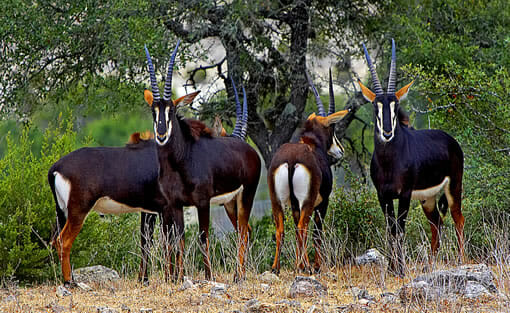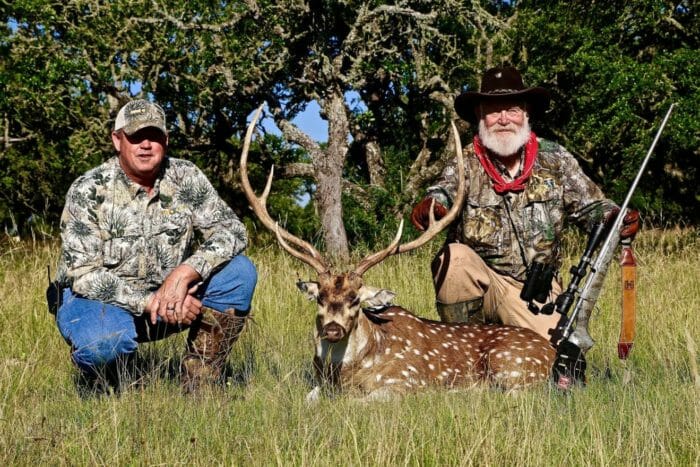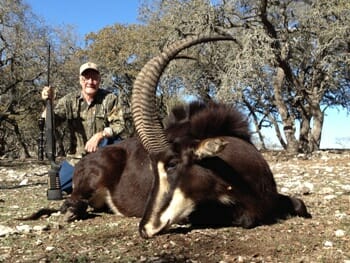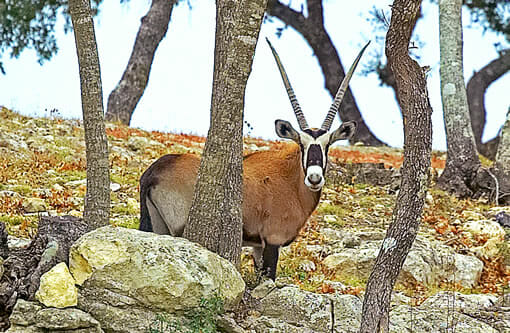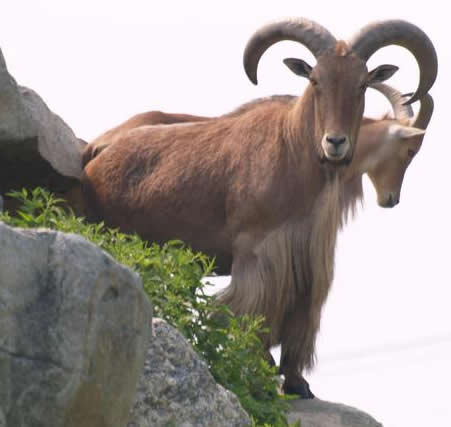How to Secure Exotic Hunts in Texas
The hunter crashes his rattling antlers together, and a monarch of a buck comes up a South Texas sendero ready to throw down. Near dusk, two dozen deer slowly make their way to the edge-cover of a hill country grain field. Large groups of feral hogs frantically crowd around a game feeder.
These are the images hunters conjure when they plan a Texas hunt. All you have to do is spend a little time watching hunting television, and you get the picture.
Texas is huge and diverse. Whitetails and other native game animals can be found across the many terrains of the Lone Star State – the East Texas piney woods, West Texas plains, and the South Texas brush country. Don’t forget the deer-rich Edwards Plateau (often called the Texas Hill Country) that sits smack-dab in the middle.
Rich in hunting tradition, Texas is home to ample opportunities to hunt exotics, too. These hunts can often be enjoyed year-round. From axis deer to Ibex, Red Stag to Scimitar Horned Oryx – there are many to choose from. In the late 1980s, it was estimated that Texas was home to 67 different species of exotics. There’s no telling what the number looks like today. If you don’t have the time or money to travel abroad to hunt these critters, this game-rich state is your answer.
So how do you set up a Texas exotic hunting trip? Well, let’s set the table first.
Exotics in Texas
First off, exotics are numerous, with literally hundreds of thousands roaming its lands. Most of the original exotics came during the 1930s and 1940s. It was during this time that Nilgai antelope were released on the vast King Ranch in South Texas. The same period brought an influx of Axis, Sika, and Blackbuck antelope. Over the following 20 years, more new species were introduced, such as red deer and mouflon sheep.
Populations of exotics in Texas have exploded since the 1988 study was done. The majority are found within the Texas Hill Country, but there are plenty to be found in other areas of the state. According to the study, more than half of the exotics resided within high fences. That still leaves many free-ranging game. The most prominent Texas exotics, in order, are axis deer, Nilgai, Blackbuck antelope, and Aoudad sheep.
Hunting Exotics
Farmers and ranchers in the mega-cattle state have been repurposing their pastures as African safari grounds for years now. And why not? They’re a legitimate income stream, and sportsmen can hunt them on hundreds of ranches, and even on public land – a win-win. Plus, most exotics are a challenging and interesting alternative to whitetails. Many ranches offer hunting opportunities with rifles, bows, and pistols.
Exotics from around the globe dwell on many of Texas’ high-fence hunting operations. These places typically offer a veritable menu of species to hunt at various price points. Make no mistake; these are far from canned hunts. You can expect to put your skills to the test, whether spot-and-stalking or still hunting.
Free Range Opportunities
Contrary to popular belief, Texas hunting isn’t solely done behind high-fences. Regardless of quality and strength, fences are compromised by hogs, flooding, and wear. Animals get out. And exotics have been doing so for decades leaving a bevy of non-native game to hunt. For years, I’ve heard assorted accounts from friends and internet forums of the time the trail camera caught such an unexpected guest.
Suffice to say; if you’ve got a problem with game fences, you’re still in luck. Many leases and hunting ranches have free-ranging exotics that travel their fields, woodlots, draws, and hills. For example, six West Texas ranches spanning hundreds of thousands of acres offer hunts for the coveted Aoudad sheep.
The Benefits
In addition to the aforementioned year-round access, hunting exotics in Texas is downright easy. There are no drawing or tag systems to deal with. You won’t have any bag limits to worry about either. If you’re a foodie or, heck, just like to eat, many of these species are downright delectable compared to whitetail venison. Finally, most exotic species make for great additions to a trophy room. I’ve yet to see a person not beaming about the definitive spots and majestic antlers of their axis mount, or the heavy horns and sandy coat of their Aoudad Sheep.
Setting Up a Texas Exotic Hunt
Drumroll, please. Unless you know someone who will let you through the pearly gates of their personal Texas hunting heaven, simply get online. Sorry to be so anti-climactic, but a simple search will yield more exotic hunting opportunities than you care to scroll through. You’ll find pricing on most ranch and outfitter webpages. Additionally, you can find alternatives on social media and Texas-based hunting forums. Many of them guided, these adventures can be found on free-range and high-fence properties alike. The former is typically more expensive but often comes with great amenities and other activities such as fishing, photography tours, and sporting clays.
Whichever you choose, non-resident licenses for Texas exotics are very reasonable. A 5-day license will cost only $48. For those wanting to stretch their trip further (or wish to return during the year), the license comes in at $132.
If you love hunting and dread the offseason, consider packing your bags for the Lone Star State. The resident exotic herds will stem the tide, sharpen your skills, and create memories for a lifetime.
Based in Texas, Jerald Kopp is President of 1st Light Hunting Journal. His articles cover a variety of topics about hunting and the outdoor lifestyle. Jerald is an avid outdoorsman with deer hunting and whitetails being by far his greatest passion. He was introduced to hunting and fishing at an early age and has been enjoying it for 40+ years. In 2005, he established the Empowerment Outfitter Network (EON) – a faith-based non-profit organization that provides hunting opportunities for disabled and terminally-ill children and youth. When not hunting, he spends his time traveling and enjoying life with Amy, his wife of over 30 years. Jerald and Amy have two adult daughters and a son-in-law.


